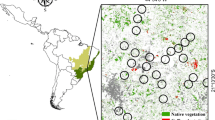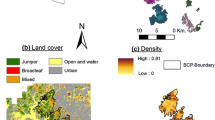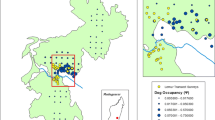Abstract
Long-term monitoring programs, wildlife surveys, and other research involving species population assessment require reliable data on population status. Given the logistically challenging nature of some species’ habitats and cryptic behaviors, collecting these data can prove to be a considerable barrier. We used detection/nondetection data from pileated gibbons (Hylobates pileatus) in the Cardamom Mountains of southwest Cambodia to estimate their population occupancy and detectability. We modeled occupancy using elevation, tree height, tree density, tree diversity, and disturbance covariates. Modeling demonstrated that 83% of the sites are occupied by Hylobates pileatus and that the detectability of the species varies positively with elevation. No clear relationship between habitat quality covariates and occupancy of Hylobates pileatus emerged. Effort analysis based on model estimates demonstrated that at high elevations, less than half the number of site visits is needed to attain the same detectability estimate precision as across all elevations. We suggest that human activities at low elevations, which affect forest composition, are the central factors impacting the detectability and occupancy of Hylobates pileatus. Longer sampling durations and/or a higher number of site visits, especially at lower elevations, increase precision of the occupancy estimator for the least effort. For effective future monitoring and research for this and similar species, using this relatively simple method, applied with repeat site visits, would allow a longitudinal comparison of detection at sites in difficult terrain.



Similar content being viewed by others
References
Bartlett, T. Q. (2003). Intragroup and intergroup social interactions in white-handed gibbons. International Journal of Primatology, 24, 239–259.
Brockelman, W. Y., & Ali, R. (1987). Methods of surveying and sampling forest primate populations. In C. W. Marsh & R. A. Mittermeier (Eds.), Primate conservation in tropical rainforests (pp. 23–63). New York: Alan R. Liss.
Brockelman, W. J., & Srikosamatara, S. (1993). Estimation of density of gibbon groups by use of loud songs. American Journal of Primatology, 29, 93–108.
Buckland, S. T., Anderson, D. R., Burnham, K. P., & Laake, J. L. (1993). Distance sampling: Estimating abundance of biological populations. New York: Chapman and Hall.
Buckley, C., Nekaris, K. A. I., & Husson, S. (2006). Survey of Hylobates albibarbis in peat swamp forest, Central Kalimantan, Borneo. Primates, 47, 327–335.
Burnham, K. P., & Anderson, D. R. (2002). Model selection and multimodel inference: A practical information-theoretic approach (2nd ed.). New York: Springer.
Caldecott, J. O. (1980). Habitat quality and populations and two sympatric gibbons (Hylobatidae) on a mountain in Malaya. Folia Primatologica, 33, 291–309.
Campbell, S. P., Clark, J. A., Crampton, L. H., Guerry, A. D., Hatch, L. T., Hosseini, P. R., et al. (2002). An assessment of monitoring efforts in endangered species recovery plans. Ecological Applications, 12, 674–681.
Carrete, M., Sánchez-Zapata, Martínez, J. E., & Calvo, J. F. (2002). Predicting the implications of conservation management: a territorial occupancy model of Bonelli's eagle in Murcia, Spain. Oryx, 36, 349–356.
Cheyne, S. M., Hoing, A., Rinear, J., & Sheeran, L. K. (2012). Sleeping site selection by agile gibbons: the influence of tree stability, fruit availability and predation risk. Folia Primatologica, 83, 299–311.
Chivers, D. (2005). Gibbons: The small apes. In J. Caldecott & L. Miles (Eds.), World atlas of the great apes and their conservation (pp. 205–214). Berkeley: University of California Press.
Cooch, E., & White, G. (2010). Program MARK: A gentle introduction (9th ed.). Retrieved November 11, 2011 from http://www.phidot.org/software/mark/docs/book/.
Coudrat, C. N. Z., Rogers, L. D., & Nekaris, K. A. I. (2011). Abundance of primates reveals Samkos Wildlife Sanctuary, Cardamom Mountains, southwest Cambodia as a priority area for their conservation. Oryx, 45, 427–434.
Donovan, T. M., & Hines, J. (2007). Exercises in occupancy modeling and estimation. Retrieved between July 28, 2010 and August 30, 2010 from http://www.uvm.edu/envnr/vtcfwru/spreadsheets/occupancy.htm.
Efford, M. G., & Dawson, D. K. (2012). Occupancy in continuous habitat. Ecosphere, 3, article 32.
Elith, J., Graham, C. H., Anderson, R. P., Dudík, M., Ferrier, S., Guisan, A., et al. (2006). Novel methods improve prediction of species’ distributions from occurrence data. Ecography, 29, 129–151.
Fan, P., & Jiang, X. (2010). Altitudinal ranging of black-crested gibbons at Mt. Wuliang, Yunnan: effects of food distribution, temperature and human disturbance. Folia Primatologica, 81, 1–9.
Fan, P., Ni, Q., Sun, G., Huang, B., & Jiang, X. (2009). Gibbons under seasonal stress: the diet of the black crested gibbon (Nomascus concolor) on Mt. Wuliang, Central Yunnan, China. Primates, 50, 37–44.
Ganzhorn, J. U. (2003). Habitat description and phenology. In J. M. Setchell & D. J. Curtis (Eds.), Field and laboratory methods in primatology (pp. 40–56). Cambridge: Cambridge University Press.
Geissmann, T., & Orgeldinger, M. (2000). The relationship between duet songs and pair bonds in siamangs, Hylobates syndactylus. Animal Behaviour, 60, 805–809.
Geissmann, T., Vu Ngoc Thanh, Dine, M. C., & Tu Minh Tiep. (2009). Results of a Gibbon Survey in the Kim Hy Nature Reserve (Bac Kan Province) in northeastern Vietnam. People Resources Conservation Foundation.
Gittins, S. P. (1980). Territorial behaviour in the agile gibbon. International Journal of Primatology, 1, 381–399.
Grieg-Gran, M., de la Harpe, D., McGinley, J., MacGregor, J., & Bond, I. (2008). Sustainable financing of protected areas in Cambodia: Phnom Aural and Phnom Samkos wildlife sanctuaries. International Institute for Environment and Development Environmental Economics Programme.
Gu, W., & Swihart, R. K. (2004). Absent or undetected? Effects of non-detection of species occurrence on wildlife–habitat models. Biological Conservation, 116, 195–203.
Guillera-Arroita, G., Lahoz-Monfort, J. J., Milner-Gulland, E. J., Young, R. P., & Nicholson, E. (2010). Using occupancy as a state variable for monitoring the Critically Endangered Alaotran gentle lemur (Hapalemur alaotrensis). Endangered Species Research, 11, 157–166.
Hilario, R. R., Rodrigues, F. H. G., Chiarello, A. G., & Mourthe, I. (2012). Can roads be used as transects for primate population surveys? Folia Primatologica, 83, 47–55.
Hines, J. E. (2006). PRESENCE4– Software to estimate patch occupancy and related parameters. USGS-PWRC. Retrieved from http://www.mbr-pwrc.usgs.gov/software/presence.shtml. Accessed 20 Feb 2013.
Johns, A. D. (1985). Behavioral responses of two Malaysian primates (Hylobates lar and Presbytis melalophos) to selective logging: Vocal behavior, territoriality, and nonemigration. International Journal of Primatology, 6(4), 423–433.
Keane, A., Hobinjatovo, T., Razafimanahaka, H. J., Jenkins, R. K. B., & Jones, J. P. G. (2012). The potential of occupancy modeling as a tool for monitoring wild primate populations. Animal Conservation, 15, 457–465.
MacKenzie, D. (2005). What are the issues with presence-absent data for wildlife managers? The Journal of Wildlife Management, 69, 849–860.
MacKenzie, D. I., & Bailey, L. L. (2004). Assessing the fit of site-occupancy models. Journal of Agricultural, Biological, and Environmental Statistics, 9, 300–318.
MacKenzie, D. I., Nichols, J. D., Lachman, J. B., Droege, J., Royal, J. A., & Langtimm, C. A. (2002). Estimating site occupancy rates when detection probabilities are less than one. Ecology, 83, 2248–2255.
MacKenzie, D. I., Nichols, J. D., Royle, J. A., Pollock, K. H., Bailey, L. L., & Hines, J. E. (2006). Occupancy estimation and modeling: Inferring patterns and dynamics of species. Burlington: Elsevier Academic Press.
McConkey, K. R., Ario, A., Firmann, A., & Chivers, D. J. (2003). Influence of forest seasonality on gibbon food choice in the rain forests of Barito Ulu, Central Kalimantan. International Journal of Primatology, 24, 19–32.
Mitani, J. C. (1985). Gibbon song duets and intergroup spacing. Behaviour, 92, 59–96.
Molles, M. C., Jr., & Cahill, J. F., Jr. (1999). Ecology: Concepts and applications. Toronto: McGraw-Hill Ryerson.
Nijman, V. (2001). Effect of behavioural changes due to habitat disturbance on density estimation of rain forest vertebrates as illustrated by gibbons (Primates: Hylobatidae). In P. J. M. Hillegers & H. H. de Iongh (Eds.), The balance between biodiversity conservation and sustainable use of tropical rain forests (pp. 217–225). Wageningen: Tropenbos Foundation.
Nijman, V. (2004). Conservation of the Javan gibbon Hylobates moloch: Population estimates, local extinctions, and conservation priorities. Raffles Bulletin of Zoology, 52, 271–280.
Nijman, V., & Menken, S. B. J. (2005). Assessment of census techniques for estimating density and biomass of gibbons (Primates: Hylobatidae). Raffles Bulletin of Zoology, 53, 201–211.
Olson, G. S., Anthony, R. G., Forsman, E. D., Ackers, S. H., Loschl, P. J., Reid, J. A., et al. (2005). Modeling of site occupancy dynamics for northern spotted owls, with emphasis on the effects of barred owls. Journal of Wildlife Management, 69, 918–932.
Pellet, J., & Schmidt, B. (2005). Monitoring distributions using call surveys: Estimating site occupancy, detection probabilities and inferring absence. Biological Conservation, 123, 27–35.
Phoonjampa, R., Koenig, A., Borries, C., & Gale, G. A. (2010). Selection of sleeping trees in pileated Gibbons (Hylobates pileatus). American Journal of Primatology, 72, 617–625.
Pollock, K. H., Nichols, J. D., Simons, T. R., & Sauer, J. R. (2002). Large scale wildlife monitoring studies: Statistical methods for design and analysis. Environmetrics, 13, 1–15.
Ross, C., & Reeve, N. (2003). Survey and census methods: Population distribution and density. In J. M. Setchell & D. J. Curtis (Eds.), Field and laboratory methods in primatology: A practical guide (pp. 90–109). Cambridge: Cambridge University Press.
Sarou, L. (2009). Livelihood strategies among indigenous peoples in the Central Cardamom Protected Forest, Cambodia. Singapore: S. Rajaratnam School of International Studies, Nanyang Technological University.
Sutherland, W. J. S. (2006). Ecological census techniques. Cambridge: Cambridge University Press.
Traeholt, C., Bonthoeun, R., Virak, C., Samuth, M., & Vutthin, S. (2006). Song activity of the pileated gibbon, Hylobates pileatus, in Cambodia. Primate Conservation, 21, 139–144.
Tyre, A. J., Tenhumberg, B., Field, S. A., Niejalke, D., Parris, K., & Possingham, H. P. (2003). Improving precision and reducint bias in biological surveys: estimating false-negative error rates. Ecological Applications, 13, 1790–1801.
Vereecke, E. E., D’Août, K., & Aerts, P. (2006). Locomotor versatility in the white-handed gibbon (Hylobates lar): A spatiotemporal analysis of the bipedal, tripedal, and quadrupedal gaits. Journal of Human Evolution, 50, 552–567.
Webb, C. (2005). Vegetation mapping in Phnom Samkos and Phnom Aural Wildlife Sanctuaries, Cardamom Mountains, Cambodia. Phonm Penh: MoE-FFI Cardamom Mountains Wildlife Sanctuaries Project.
Zhu, X., & Zhang, J. (2009). Quartered neighbor method: a new distance method for density estimation. Frontiers of Biology in China, 4, 574–578.
Acknowledgments
We thank T. Eastoe, N. Furey, R Sethik, and staff from Fauna and Flora International, Cambodia Programme, and the Royal University of Phnom Penh for their logistical help and advice. Hun Seiha and Kimleng Chuon are thanked for their assistance in the field. We thank the reviewers for useful comments that contributed to the improvement of the manuscript. Primate Conservation Inc. and the American Society of Primatologists funded this project.
Author information
Authors and Affiliations
Corresponding author
Rights and permissions
About this article
Cite this article
Neilson, E., Nijman, V. & Nekaris, K.A.I. Conservation Assessments of Arboreal Mammals in Difficult Terrain: Occupancy Modeling of Pileated Gibbons (Hylobates pileatus). Int J Primatol 34, 823–835 (2013). https://doi.org/10.1007/s10764-013-9688-6
Received:
Accepted:
Published:
Issue Date:
DOI: https://doi.org/10.1007/s10764-013-9688-6




